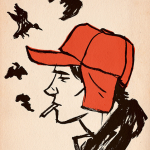Every week in The Kiddy Pool, Erin Newcomb confronts one of many issues that parents must deal with related to popular culture.
I took my daughter’s apparel for The Nutcracker seriously. I did her hair just like the girl on the cover of Janet Shulman’s adaptation of the classic Christmas tale, the one we’ve been reading and re-reading for months. I made sure she wore her pink tutu, and she, of course, picked out the red sparkly shoes; we did our best to approximate the grandeur appropriate for a trip to the Land of Toys, or at least the community ballet. We took our seats, and as the lights dimmed, we ventured off to that magical place that only live theater can inspire—a mix of wonder and awe because somehow the enchanted action is only an arm’s length away. My daughter sat next to me, her legs stretched out as she propped herself on the pile of our coats. I watched her watching the ballet, and as the audience around us erupted into applause, she put down her Rudolph doll and clapped along, her eyes never leaving the stage.
My introduction to Nutcracker is one of many ways that my daughter has transformed Christmas for me. I am now familiar with Tchaikovsky’s music and find myself humming it, entranced by the beautiful movement even though I know little about formal music appreciation. We’ve watched the Pacific Northwest Ballet’s Nutcracker multiple times as well, where the costumes designed by Maurice Sendak add a layer of darkness that’s easy to overlook in the storybook version. This is a story that centers on a battle, the beleaguered Nutcracker against the malicious forces of the seven-headed Mouse King. And Clara is no mere cowering princess; she helps Nutcracker defeat the Mouse King twice and, in between the battles, sacrifices her precious possessions to protect him from the gruesome royal rodent. It is a classic fairytale that pits good versus evil and rewards the patient protagonists beyond our wildest dreams—with a kingdom of sweets and toys, music and dance.
Knowing the Nutcracker’s story, I understand now why this tale serves as a Christmas staple. Nutcracker comes to Clara as a gift, and he is dependent upon her care and kindness. The hero engages in an epic battle and wins, vanquishing evil with the help of unlikely assistants—toys and candies and a child. He is transported to a paradise where he reigns as prince, a kingdom won because Clara loved Nutcracker in spite of his ugliness. As she dances with her prince in the Land of Toys, the foil to the story’s opening seems clear; instead of the mechanical, rote toys of Clara’s Godfather Drosselmeir, the Land of Toys is alive, vibrant, teeming with music that uplifts as it enchants. A vulnerable prince. A war against evil. A crew of misfits. A transforming, undeserved love. A paradise that makes life before seem mechanical, less life-like than the waking dream. Sound familiar?
It is a story for children and a story for Christians, a story of faith in things that are lovely, if only on the interior. It is a story of delights in earthly pleasures like sweets and toys and in transcendent joys like the love that can elevate us even though we are ugly and undeserving. The story, the music, played out in a live performance complete with fluttering artificial snow, was enough to make my daughter put down her beloved Rudolph and applaud. That is some kind of magic. For a moment I just watched her watching this story unfold, wondering what captivates her so about Christmas, about the Nutcracker. And then the music drew my attention back to the stage, to the stunning apotheosis, my mind marveling at the swirling tutus and pointed toes. I knew, in that torrent of music, that wave of applause, that I too had been swept into the magic of Nutcracker’s world, my daughter’s world, where beauty reigns triumphant, conquering us from the inside out.












